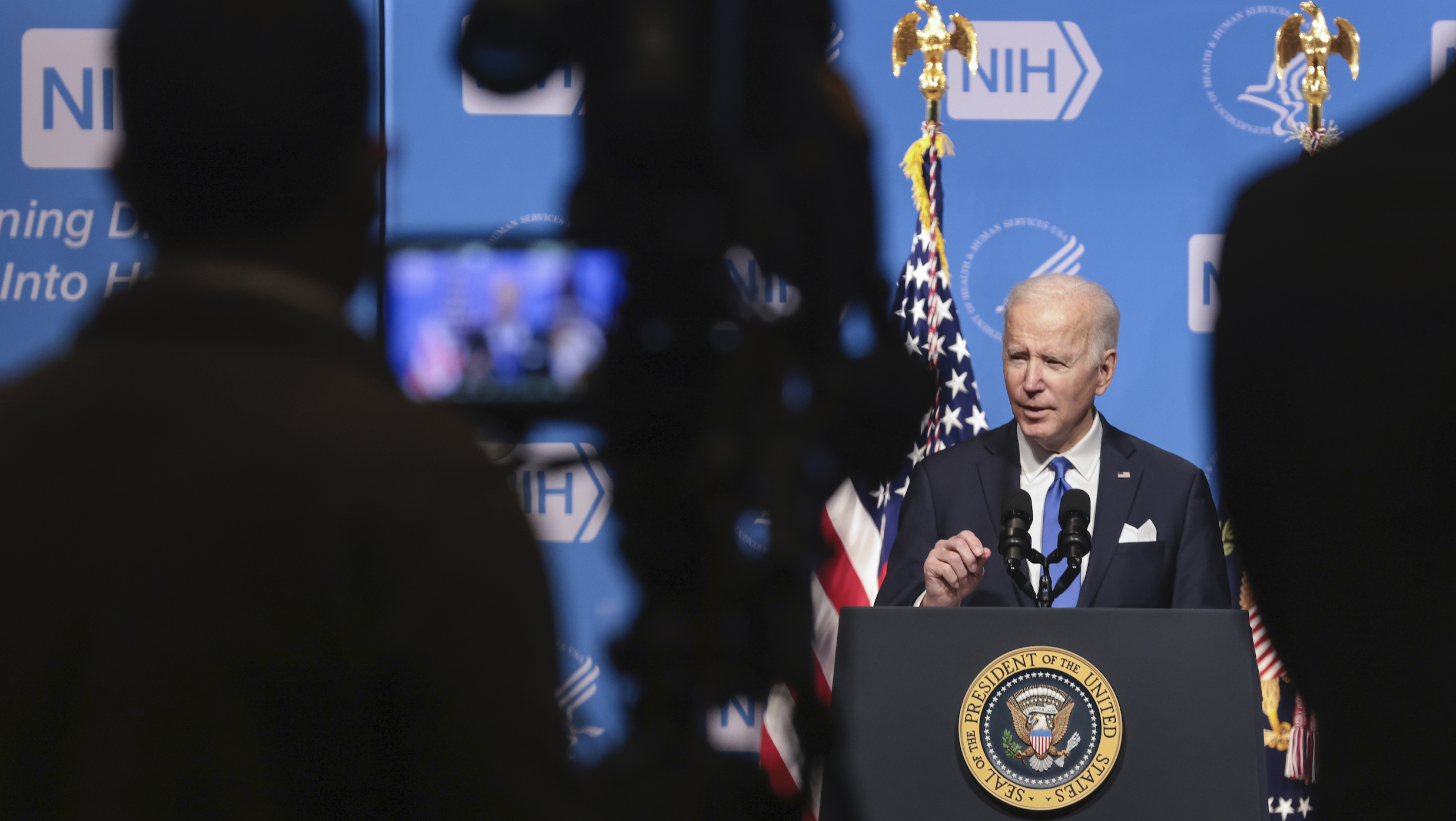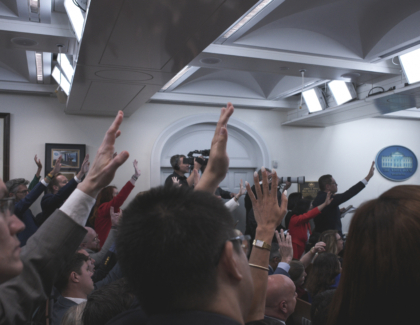Sign up for the daily CJR newsletter.
In recent weeks, a pair of trends moving in opposite directions—President Biden’s approval rating (down) and prices (up)—have dominated coverage of the White House, and the White House seems pretty annoyed about that fact. Senior staffers including Ron Klain, the chief of staff, and outside Biden allies have publicly criticized the media for what they see as a distorted and disproportionate focus on what’s bad about the economy, rather than what’s good about it; top officials reportedly even led briefings for major newsrooms on supply-chain and other issues, making the case that the US is in a much better economic position than a year ago. Last Thursday, dozens of liberal groups wrote to key media players to complain about a “pervasive pattern of under-reporting and negative bias toward the actions and agenda of this administration”; meanwhile, Kurt Bardella, a Democratic adviser, complained to The Hill about “a barrage” of “unimportant high-school tabloid-style garbage,” like stories about Biden coughing during a speech on jobs. On Friday, Biden went on Jimmy Fallon’s show for his first late-night appearance as president. “People are worried, and people are getting so much inaccurate information to them—I don’t mean about me, but about their situation,” Biden said, turning serious after joking about his low approval rating. “They’re being told that Armageddon’s on the way.”
Media critics and columnists have weighed in, too, criticizing gloomy coverage of the economy in particular and Biden’s job performance in general—especially when compared to that of the last guy in the Oval Office. One column, by Dana Milbank, of the Washington Post, sparked especially lively debate. Milbank listed a string of recent headlines in Politico’s influential Playbook newsletter and noted that his “impression of other outlets’ coverage of President Biden had been much the same: unrelentingly negative,” before making the case that this isn’t just a figment of his imagination. Milbank commissioned a data firm to, in his words, “measure the negativity with precision” by using artificial intelligence to run a “sentiment analysis” of language that appeared in more than two hundred thousand articles across sixty-five news websites between January and November of this year (to assess coverage of Biden) and the same period last year (to compare it with coverage of then-President Trump). After a honeymoon, “Biden’s press for the past four months has been as bad as—and for a time worse than—the coverage Trump received for the same four months of 2020,” Milbank wrote, a trend that he sees as tantamount to media complicity in “the murder of democracy.” The US, he argued, “is in an existential struggle between self-governance and an authoritarian alternative. And we in the news media, collectively, have given equal, if not slightly more favorable, treatment to the authoritarians.”
Podcast: Twitter on a tightrope
Klain shared the column on Twitter, with the caption “submitted for your consideration”; other White House officials promoted it, too, while various media critics endorsed Milbank’s analysis. Not that everyone agreed. “I think this point of view is very wrong,” Ross Douthat wrote in the New York Times, of Milbank’s argument, adding that journalists not only have an obligation to the truth “that cannot be set aside for the sake of certain political results, however desirable for democracy those results may seem,” but that shirking this duty would prove counterproductive, by eroding news consumers’ trust. Writing in the New Republic, Jason Linkins reached a similar conclusion from a different direction. “Blind fealty to heads of state is the hallmark of dictatorships, not democracies,” Linkins wrote. “No true ‘partisan for democracy’ can simply be a reflexive defender of a politician.” Some observers, meanwhile, eviscerated the methodology of Milbank’s sentiment analysis. Nate Silver, of the data-driven news site FiveThirtyEight, called it “complete crap,” and its algorithm faulty. The article about Biden that had the most positive score appeared in the conservative Washington Examiner and excoriated Democrats’ plans for “higher taxes.” (As Silver notes, the analysis may have misunderstood “high” as positive without judging context.) The article with the sixth-most positive score was about the assassination of Haiti’s president.
I lack Silver’s data expertise but I, too, was highly skeptical of Milbank’s sentiment analysis, which doesn’t, to my mind, really prove anything meaningful. This is not to say that Milbank’s observations—that coverage of Biden has been “unrelentingly negative,” and that reporters are failing to be “partisans for democracy”—are necessarily wrong. And the urge to quantify media framing at a large scale is understandable, given how often political journalists dismiss qualitative media criticism as overly general. But the topline numbers that Milbank offers don’t say anything about how he’s right, or what coverage is bad and why. Even if you assume that the sentiment analysis does reasonably and consistently capture the media’s actual judgments (which is a big if), comparing the numbers for Biden to those for Trump doesn’t really prove Milbank’s opening hypothesis that Biden’s coverage, in isolation, is overly negative. Should Biden’s numbers be higher? Or Trump’s lower? Or both? The data doesn’t offer a framework for assessing such questions. (Nor does it compare coverage across the same time period.)
More fundamentally, I simply don’t think media criticism is reducible to quantitative measures. Sure, media critics can marshal data points—the number of times a given topic was mentioned on cable news in a given period, say—to build an argument, but those rarely, if ever, prove the argument, or why it matters. And counting mentions, clearly, is a much easier task than quantifying language, the meaning of which is messy and inconsistent across different outlets and writers, even before you get into contextual misunderstandings over high taxes. Media criticism is inevitably impressionistic and subjective to a high degree. That’s not a free pass to make sweeping statements about coverage with no evidence whatsoever to back it up, and it doesn’t mean that all media criticism is equally valid. Nor does subjectivity render media criticism pointless as a craft. In the end, it fuels a debate that can’t be short-circuited by a single dataset, of any quality. You don’t need to scan two hundred thousand articles to justify slamming Playbook.
Which brings us back to the key question here: is Milbank right? Is Ron Klain? The answer (beyond noting that politicians grumbling about their coverage isn’t unusual in a democracy) is complicated, and ties into a question of balance that I first wrote about more than a year ago. Reporters should not cover Biden as negatively as they covered Trump in some misguided pursuit of “neutrality”; at the same time, the Trump era awakened many reporters to problems in American governance that go beyond Trump, and returning to an era of complacency because Trump was worse isn’t tenable either. Milbank’s data may appear to show the former problem—also known as false equivalency—in the aggregate, but I think it’s more usefully assessed within and between smaller numbers of stories that are directly comparable. The issue is not so much that Biden’s coverage is negative but what that negativity entails and whether it’s fair and substantive—and judging that requires case-by-case analysis that isn’t always served well by Trump comparisons. Much coverage of Biden has indeed been trivial (see: coughing) or lacking in perspective (see: Afghanistan), and that’s without even wading into the messy recent coverage of the economy. But there are plenty of areas in which he arguably deserves more rigorous scrutiny—not least, as Linkins noted, his relatively tepid push to protect voting rights, which are obviously essential to the survival of democracy.
A democracy that requires journalists to mute their criticism of one politician because the alternative is scarier arguably isn’t a democracy that has survived at all. To be fair, I’m not sure (contra Douthat, et al) that Milbank is quite calling for journalists to be apologists—and in isolation, his argument that media coverage of Trump’s threats to democracy could be much more urgent is fair. But that urgency won’t—and needn’t—look like keeping coverage of Biden an arbitrary fraction ahead of coverage of Trump on a sentiment graph. If there’s a comparison to be drawn here, perhaps, it’s a forward-looking one of prominence and proportion. As Will Bunch, a columnist at the Philadelphia Inquirer, put it in response to Milbank’s column, “The problem with Biden-era journalism isn’t what they write, but what they don’t write… What top U.S. journalists need to see is that Biden’s performance is A story, but the performance of the fragile American system under attack from authoritarianism is THE story.”
Below, more on media criticism, politics, and democracy:
- “Really?”: Allies of Vice President Kamala Harris have also grumbled recently about a spate of negative coverage concerning her office, not least a Politico story about her distrust (for security reasons) of Bluetooth headphones. Over the weekend, Harris herself hit out at the coverage in an interview with Tal Kopan, of the San Francisco Chronicle, calling such headlines “ridiculous.” She added, of another, “Oh, how about, ‘She’s going to buy a pot on her way to the airport,’ after a very significant and highly successful bilateral meeting in France on issues that are about national security, on issues that are about climate, on issues that are about what we are doing in terms of international norms and rules on everything from cyber to space. Come on.”
- But their emails: Maggie Astor, of the Times, read thousands of campaign email blasts sent out by members of Congress and assessed how often they contained misleading claims. “Lawmakers’ statements on social media and cable news are now routinely fact-checked and scrutinized. But email—one of the most powerful communication tools available to politicians, reaching up to hundreds of thousands of people—teems with unfounded claims and largely escapes notice,” Astor writes. “Republicans included misinformation far more often: in about 15 percent of their messages, compared with about 2 percent for Democrats. In addition, multiple Republicans often spread the same unfounded claims, whereas Democrats rarely repeated one another’s.”
- But their texts: Last night, Liz Cheney, a member of the House committee investigating the insurrection, read aloud numerous messages that Mark Meadows, Trump’s final chief of staff, received on January 6 and handed over to the committee during his brief recent period of cooperation with its probe. Among the messages were texts from three Fox News hosts—Laura Ingraham, Sean Hannity, and Brian Kilmeade—urging Meadows to get Trump to defuse the violence that day; Ingraham wrote that the insurrection was “hurting all of us” and that Trump was “destroying his legacy.” The texts, the Post’s Jeremy Barr notes, “stand in contrast with some of the messages that Ingraham, Hannity and Kilmeade sent to Fox News viewers in appearances on the night of Jan. 6.”
- No-win: Writing as part of Nieman Lab’s series of predictions about journalism in 2022, Whitney Phillips, an assistant professor at Syracuse University, argued that the politics of defending democracy are “no-win.” There “are no clean options for responding, particularly within journalism,” Phillips writes. “Fighting back against the anti-democracy faction feeds into anti-democratic attacks—but so does refusing to take up arms. This isn’t a prediction for 2022; it’s the promise of 2022.” (ICYMI, Phillips wrote for CJR’s magazine in 2019 outlining a similar conundrum around disinformation more generally.)
Other notable stories:
- Yesterday, the opinion section of the Times published “Postcards from a world on fire,” a multimedia package of snapshots showing the reality of the climate crisis in each of the 193 member states of the United Nations. The postcard from Turkey shows “sea snot” in warming waters; the postcard from Tanzania features video of wildfires on Mount Kilimanjaro. “Some of these stories will horrify you. Some may inspire you. Some may even delight you,” the Times writes. “But what they should all make clear is that climate change is real and it’s now. The only question left is how we plan to limit the damage.”
- Early yesterday, the Wall Street Journal reported that Vox Media and Group Nine were in talks to seal a digital-media mega-merger. Late yesterday, Vox confirmed that it is acquiring Group Nine; Jim Bankoff, Vox’s CEO, will lead the combined company, with Ben Lerer, Group Nine’s CEO, joining the board. As I noted last week, both Vox and Group Nine have recently flirted with going public; Bankoff told staffers that the merged company has “no immediate plans” to do that, but did not completely rule it out.
- Last night, hours after Time named Elon Musk as its person of the year, unionized staffers at the magazine rallied outside its New York headquarters in protest of stalled contract negotiations with management; talks have now dragged on for more than two years, with only print staffers covered by a prior contract. The staffers wore festive gear and sang “contract carols.” (“What fun it is to fight and sing, with our coworkers tonight.”)
- In media-jobs news, The Atlantic hired Claudine Ebeid, of the Times, to be its executive producer of audio; she’ll work closely with Andrea Valdez, who is now a managing editor. Elsewhere, the Marshall Project hired Ebony Reed, of the Journal, as its first ever chief strategy officer. And New York magazine hired Tammie Teclemariam as its first ever Diner-at-Large. She will “spend one year eating her way around New York City.”
- The New Yorker’s Lauren Collins profiled Alison Roman, the famous food writer and chef. Almost as soon as she began reporting the piece, Collins’s phone and email “lit up” with messages from sources, she writes. “Two themes emerged: the sense that Roman was both a product and a perpetuator of structural racism in food media, and a wish that her sense of social responsibility was commensurate with the size of her platform.”
- On CJR’s podcast, The Kicker, Kyle Pope, our editor and publisher, spoke with Jacob L. Nelson about his recent research for CJR and the Tow Center for Digital Journalism on journalists’ experiences of newsroom social-media policies. Newsroom managers want their staff to use social media to present themselves as people beyond their jobs, Nelson told Pope, but their “social-media policies are completely inconsistent with that goal.”
- Earlier this year, an appeals court ruled that Tony Evers, the Democratic governor of Wisconsin, did not discriminate based on viewpoint when he excluded a conservative think tank from certain press briefings, finding Evers’s “media-access criteria” to be “reasonable.” The think tank appealed to the US Supreme Court, but last week, the justices tossed out the case. Molly Beck has more for the Milwaukee Journal Sentinel.
- Amid a widespread reappraisal (including at CJR) of BuzzFeed’s decision to publish the Steele dossier on Trump and Russia in 2017, Richard J. Tofel, formerly of ProPublica, argues that BuzzFeed still made the right call. The “implicit premise” of the argument not to publish, Tofel writes, “is that all of us should trust a small, self-referential and largely homogenous group of political reporting insiders to know more than they are telling us.”
- And—after the Philadelphia Inquirer said that it will refer to Dr. Oz, who is now running for US Senate in Pennsylvania, by his name, Mehmet Oz, to avoid giving him a perceived advantage—Oz accused the paper of dropping “Dr.” in a bid to “cancel” him. (The decision was in line with the Inquirer’s style guide.) Oz’s TV show has actually been canceled, due to his campaign. A show co-hosted by Oz’s daughter will replace it.
ICYMI: Chris Wallace, an old approach, and something new
Has America ever needed a media defender more than now? Help us by joining CJR today.







